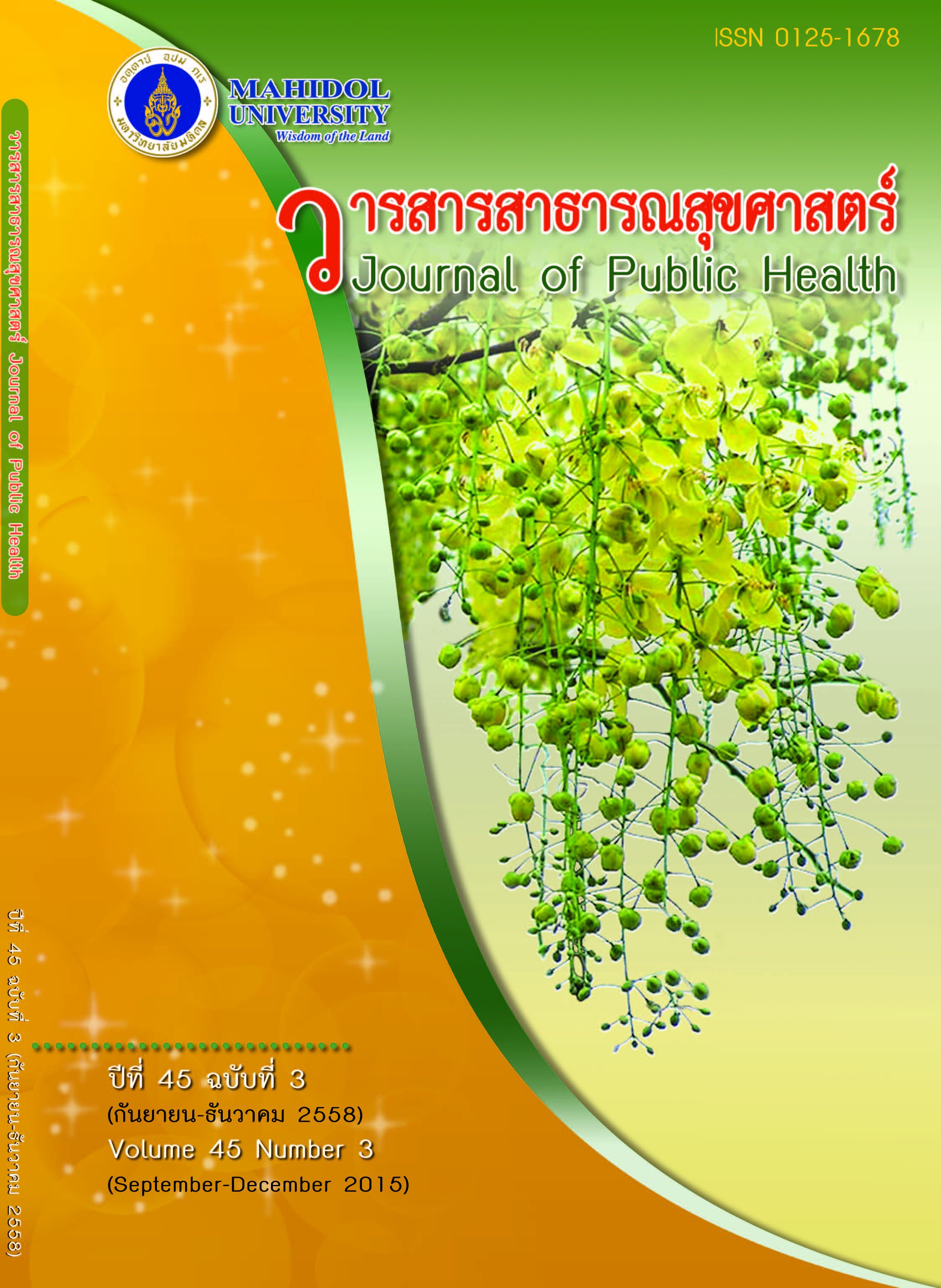การทดสอบประสิทธิภาพของน้ำมะนาวในการลดปริมาณ Escherichia coli และโคลิฟอร์มแบคทีเรียที่ปนเปื้อนในผักกาดหอมเพื่อพัฒนาเป็นน้ำยาล้างผัก
Keywords:
การทดสอบประสิทธิภาพ, น้ำมะนาว, ผักกาดหอม, การล้างผัก, E.coli, ด่างทับทิม, น้ำซาวข้าว, โคลิฟอร์มแบคทีเรีย, Efficacy, lime juice, lettuce, vegetable washing, E. coli, potassium permanganate, rice washing water, coliform bacteriaAbstract
บทคัดย่อ
การบริโภคผักสดเสี่ยงต่อการติดเชื้อโรคที่มากับอาหาร (Foodborne diseases) ผักกาดหอมเป็นผักที่นิยมนำมาบริโภคสดอย่างแพร่หลายในประเทศไทย งานวิจัยนี้จึงมีวัตถุประสงค์เพื่อเปรียบเทียบประสิทธิภาพของการใช้น้ำมะนาว น้ำซาวข้าว และด่างทับทิม ในการล้างผักกาดหอมเพื่อลดปริมาณโคลิฟอร์มแบคทีเรียที่ปนเปื้อนมากับผัก โดยการทดสอบเบื้องต้นนั้นจะทดสอบกับผักกาดหอม (Lactuca sativa) ที่มีการสร้างสภาวะปนเปื้อน (artificial inoculum) ด้วยเชื้อ E. coli โดยหาปริมาณเชื้อ E. coli หลังจากการแช่ผักกาดหอมในสารดังกล่าวข้างต้น จากนั้นนับจำนวนด้วยวิธี Spread plate technique บนอาหารเลี้ยงเชื้อ Eosin Methylene Blue (EMB) agar โดยใช้น้ำกลั่นปราศจากเชื้อเป็นตัวควบคุม จากการศึกษาพบว่าน้ำมะนาวมีประสิทธิภาพในการลดปริมาณเชื้อได้ดีที่สุด สามารถลดปริมาณเชื้อ E. coli ที่มาจากการสร้างสภาวะปนเปื้อนในผักกาดหอมได้มากกว่าด่างทับทิมได้อย่างมีนัยสำคัญที่ระดับความเชื่อมั่น99% ในขณะที่น้ำซาวข้าวไม่มีประสิทธิภาพในการลดปริมาณเชื้อ E. coli ในผักกาดหอมเลย จากนั้นนำน้ำมะนาวที่ระดับความเข้มข้นแตกต่างกัน (2.5%, 5%, 10% และ 15%) มาทดสอบหาประสิทธิภาพในการลดปริมาณโคลิฟอร์มแบคทีเรียที่ปนเปื้อนจริงในผักกาดหอม พบว่าน้ำมะนาวที่ความเข้มข้น 15% มีประสิทธิภาพในการลดปริมาณเชื้อโคลิฟอร์มแบคทีเรีย ได้ดีที่สุดได้อย่างมีนัยสำคัญที่ระดับความเชื่อมั่น 99% รองลงมาคือน้ำมะนาวที่ความเข้มเข้น 10%, 5% และ 2.5% ตามลำดับ ดังนั้นจึงน่าที่จะศึกษาเพื่อพัฒนาน้ำมะนาวเป็นน้ำยาล้างผักที่มีประสิทธิภาพต่อไป
Efficacy of Lime Juice as a Vegetable-washing Liquid in Reducing Escherichia coli
and Coliform Bacteria Contaminated in Lettuce
ABSTRACT
Consumption of raw vegetables risks consumers’ health in contracting foodborne diseases. Fresh lettuce is popularly consumed in Thailand. Therefore, the objective of this study was to compare the effectiveness of lime juice, rice washing water and potassium permanganate as vegetable-washing liquid in reducing the number of contaminated coliform bacteria in lettuce. A preliminary assessment was performed by testing the ability of the sample material to reduce the number of artificially inoculated E. coli in lettuce (Lactuca sativa). After each piece of lettuce was separately soaked in lime juice, rice washing water and potassium permanganate, the number of artificially inoculated E. coli was determined by spread plate technique on Eosin Methylene Blue (EMB) agar. Sterile distilled water was used as a control. The result showed that among the test materials, lime juice gave the highest ability in reducing the number of E. coli; it could significantly reduce the number of E. coli more than potassium permanganate at 99% confidence, whereas rice-water showed no ability at all. When different concentrations of lime juice (2.5%, 5%, 10% and 15%) were tested for the ability to decrease the number of coliform bacteria contaminated in lettuce, at the 99% confidence, lime juice at the concentration of 15% could significantly reduce the number of coliform bacteria more than lime juice at the other concentrations. Thus, lime juice should be further studied to make it a more efficient vegetable washing liquid.
Downloads
Issue
Section
License
Creative Commons License CC-BY-ND


